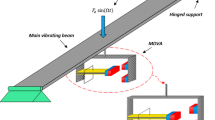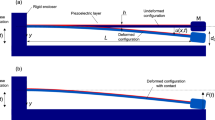Abstract
Purpose
With the rapid development of rail transit, it is becoming more demanding to structural health monitoring (SHM) of long-span tracks. In order to ensure the safe operation of railway systems, it is crucial to supply power for wayside monitoring sensing devices.
Methods
A hybrid piezoelectric-electromagnetic energy harvester (HPEH) based on wheel-rail vibration is designed to supply power for wayside monitoring sensing devices. The coupling model of control equation of hybrid energy harvester and wheel-rail dynamics is built to devote the relationship between the output power of hybrid energy harvester and external excitation signal. HPEH is fabricated and fixed onto the track wrist for harvesting the wheel-rail vibration energy for power supply of wayside monitoring sensing devices.
Results
By theoretical analysis, finite element modeling (FEM), and experiment validation, the maximum voltage of bistable HPEH reaches at either 150 or 260 Hz. The bistable HPEH has the output voltage 2.12 V and the output power of 266.4 mW. Field tests have validated that HPEH is applied to power supply of wayside monitoring sensing devices successfully by converting vibration energy into electrical energy.
Conclusions
New multi-stable energy harvester has great prospects and reliability in the power supply to wayside sensing devices to long-term SHM of the railway system for promoting the intelligent sensing level of the track.















Similar content being viewed by others
Data availability
The data are available from the corresponding authors on reasonable request.
Abbreviations
- PE:
-
Piezoelectric
- EM:
-
Electromagnetic
- SD:
-
Spectral density
- MEMS:
-
Micro electro mechanical systems
- HPEH:
-
Hybrid PE–EM energy harvester
- z(t):
-
Amplitude of piezoelectric cantilever beam
- a(t):
-
Excitation acceleration
- me :
-
Effective mass
- Cm :
-
Mechanical damping coefficient
- Ke :
-
Stiffness
- Rp :
-
Load resistance of PE element
- Iem :
-
Output current of EM element
- Rc :
-
Resistance of coils
- Lc :
-
Inductance of coils
- Rm :
-
Load resistance of EM element
- θ :
-
PE transfer factors
- ge :
-
EM transfer factors
- Fm :
-
Force between magnets
- Cp :
-
Equivalent capacitance of PE layer
- SA(w):
-
Spectral density
- ω:
-
Excitation frequency
- Vp :
-
Output voltage of PE element
- μ :
-
Correction factor
- μ0 :
-
Magnetic permeability
References
Sasi D, Philip S, David R et al (2020) A review on structural health monitoring of railroad track structures using fiber optic sensors. Mater Today Proc 33:3787–3793
Wang Y, Tian J, Sun Z et al (2020) A comprehensive review of battery modeling and state estimation approaches for advanced battery management systems. Renew Sustain Energy Rev 131:110015
Wang Q, Wang Z, Mo J et al (2023) Effect and mechanism of wheel–rail adhesion on torsional vibration and stability of the braking system. Tribol Int 179:108182
Ma X, Li H, Zhou S et al (2022) Characterizing nonlinear characteristics of asymmetric tristable energy harvesters. Mech Syst Signal Process 168:108612
Aouali K, Kacem N, Bouhaddi N (2022) Functionalization of internal resonance in magnetically coupled resonators for highly efficient and wideband hybrid vibration energy harvesting. Sensors 22(19):7657
Litak G, Margielewicz J, Gąska D et al (2022) On theoretical and numerical aspects of bifurcations and hysteresis effects in kinetic energy harvesters. Sensors 22(1):381
Suzuki YJPP (2010) Development of a MEMS energy harvester with high-performance polymer electrets. 47–52
Zhang J, Wang C, Bowen C (2014) Piezoelectric effects and electromechanical theories at the nanoscale. Nanoscale 6(22):13314–13327
Naruse Y, Matsubara N, Mabuchi K et al (2009) Electrostatic micro power generation from low-frequency vibration such as human motion. J Micromech Microeng 19(9):094002
Ryu H, Yoon HJ, Kim SW (2019) Hybrid energy harvesters: toward sustainable energy harvesting. Adv Mater 31(34):1802898
Doi M, Oba M (2010) Development and application of a compact vibration-driven micropower generator using electret materials. Funct Mater 30(10):21–28
Park JY, Salauddin M, Rasel MS (2019) Nanogenerator for scavenging low frequency vibrations. J Micromech Microeng 29(5):053001
Erturk A, Inman DJ (2011) Broadband piezoelectric power generation on high-energy orbits of the bistable duffing oscillator with electromechanical coupling. J Sound Vib 330(10):2339–2353
Yao M, Zhang W, Yao Z (2015) Nonlinear Vibrations and Chaotic Dynamics of the Laminated Composite Piezoelectric Beam. J Vib Acoust 137(1):011002
Ferrari M, Ferrari V, Guizzetti M et al (2009) Improved energy harvesting from wideband vibrations by nonlinear piezoelectric converters. Proc Chem 1(1):1203–1206
Mann BP, Owens BA (2010) Investigations of a nonlinear energy harvester with a bistable potential well. J Sound Vib 329(9):1215–1226
Foisal ARM, Hong C, Chung G-S (2012) Multi-frequency electromagnetic energy harvester using a magnetic spring cantilever. Sens Actuators A Phy 182:106–113
Challa VR, Prasad MG, Fisher FT (2009) A coupled piezoelectric–electromagnetic energy harvesting technique for achieving increased power output through damping matching. Smart Mater Struct 18(9):095029
Tadesse Y, Shujun Z, Priya S (2008) Multimodal energy harvesting system: piezoelectric and electromagnetic. J Intell Mater Syst Struct 20(5):625–632
Mahmoudi S, Kacem N, Bouhaddi N (2014) Enhancement of the performance of a hybrid nonlinear vibration energy harvester based on piezoelectric and electromagnetic transductions. Smart Mater Struct 23(7):075024
Edwards B, Hu PA, Aw KC (2016) Validation of a hybrid electromagnetic–piezoelectric vibration energy harvester. Smart Mater Struct 25(5):055019
Wu L, Li H, Zhang G (2016) Design of a new nonlinear hybrid piezoelectric and electromagnetic energy harvester. 38: 570–574
Li P, Gao S, Zhou X et al (2017) Analytical modeling, simulation and experimental study for nonlinear hybrid piezoelectric–electromagnetic energy harvesting from stochastic excitation. Microsyst Technol 23(12):5281–5292
Li P, Gao S, Zhou X et al (2017) On the performances of a nonlinear hybrid piezoelectric and electromagnetic energy harvester. Microsyst Technol 24(2):1017–1024
Dong L, Zuo J, Wang T et al (2022) Enhanced piezoelectric harvester for track vibration based on tunable broadband resonant methodology. Energy 254:124274
Gao M, Yang F, Wang P (2018) Symplectic analysis of stationary random vibration of vehicle–track coupled system with rail-borne electromagnetic generator. Adv Mech Eng 10(10):1687814018804746
Debnath B, Kumar R (2021) A piezoelectric energy harvester designed for vibration energy scavenging and shaft fault diagnosing-based applications. J Vib Eng Technol 9(6):1387–1398
Jin L, Deng WL, Su YC et al (2017) Self-powered wireless smart sensor based on maglev porous nanogenerator for train monitoring system. Nano Energy 38:185–192
Cleante VG, Brennan MJ, Gatti G et al (2019) On the target frequency for harvesting energy from track vibrations due to passing trains. Mech Syst Signal Process 114:212–223
Geng LX, Bian S, Li T, et al (2018) Application of triboelectric nanogenerator in the railway system. In: International conference on electrical and information technologies for rail transportation. Springer Verlag pp. 895–904
Xu Z, Wang X, Zhang Y (2023) Enhanced performances by tri-stable vibration absorber and energy harvester with negative ground connecting stiffness for impulse response. J Vib Eng Technol 11(3):1177–1196
Zhang Y, Wang X, Du Q, et al (2023) Design of a lightweight quasi-zero stiffness electromagnetic energy harvester for low-frequency vibration. J Vib Eng Technol 1-11
Maroofiazar R, Fahimi FM (2023) A hybrid vibration energy harvester: experimental investigation, numerical modeling, and statistical analysis. J Vib Eng Technol 11(4):1575–1593
Acknowledgements
This research is supported by: National Natural Science Foundation of China (52165069), Natural Science Foundation of Jiangxi Province (20224BAB214051), Opening funding from State Key Lab of Digital Manufacturing Equipment and Technology (IMETKF2023013), and Jiangxi Province Graduate Innovation Special Fund Project Support (YC2023-S508).
Author information
Authors and Affiliations
Contributions
WD: Conceptualization, Methodology, Investigation, Writing-original draft and Funding acquisition. CZ: Methodology, Investigation, Formal analysis, Software and Writing-original draft. XP: Validation and Formal analysis. WX: Validation and Formal analysis. XC: Methodology, Conceptualization and Supervision.
Corresponding author
Additional information
Publisher's Note
Springer Nature remains neutral with regard to jurisdictional claims in published maps and institutional affiliations.
Rights and permissions
Springer Nature or its licensor (e.g. a society or other partner) holds exclusive rights to this article under a publishing agreement with the author(s) or other rightsholder(s); author self-archiving of the accepted manuscript version of this article is solely governed by the terms of such publishing agreement and applicable law.
About this article
Cite this article
Dong, W., Zhu, C., Pan, X. et al. Nonlinear Model and Experimental Verification of Bistable Hybrid Energy Harvester Based on Wheel–Rail Vibration. J. Vib. Eng. Technol. (2024). https://doi.org/10.1007/s42417-024-01350-y
Received:
Revised:
Accepted:
Published:
DOI: https://doi.org/10.1007/s42417-024-01350-y




